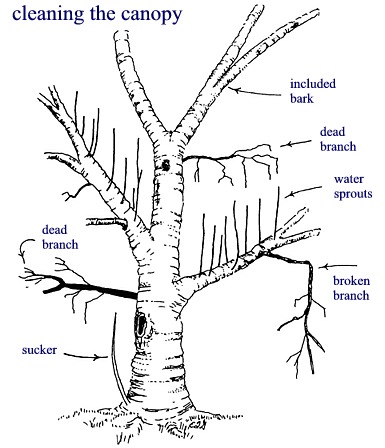Home > Pruning shade trees > Cleaning the canopy
Cleaning the canopy

Photo examples of cleaning
Printer-friendly (2 page pdf)
Objectives
Reduce conditions in the tree that could place people or property at risk. Remove dead, cracked, touching, and broken branches.
Included bark: Inclusions in the branch union make the union weak (See: bark inclusion examples). Branches could split apart'. 1) Either remove one of the branches entirely back to the base of the included bark, 2) reduce the weight on the end of one branch by removing lateral branches toward the end of the branch, 3) consider shortening one branch with a reduction cut, or 4) consider installing a cable system.
Dead or touching branches: Remove detached, dead, broken, and diseased branches especially those more than one inch in diameter. Never remove the swollen expanding collar growing around the base of dead branches. Cut just to the outside of this collar. If two branches touch, remove or shorten one of them so they no longer touch.
Water sprouts: Remove some water sprouts, if you wish. But remember that trees usually produce water sprouts due to a stress like root loss, root damage, storm damage, loss of branches, topping, disease, over-pruning, improper thinning, drought, and other reasons. Determine the cause of sprouting and correct it. It is often best to leave many of the sprouts unless there are more than a dozen or so on a branch. Space the sprouts along the branch by removing some. If too many sprouts are removed at once, they will grow back. Some trees sprout more than others.
Suckers: Remove suckers (sprouts from the base of the plant or from roots) as they appear. Sprays and paints containing NAA (synthetic auxin) applied to the pruning cuts can help reduce subsequent suckering on some species.
Introduction
If regular pruning is not performed, most trees develop canopies containing dead, detached, cracked, or damaged branches. If left untreated, these branches could pose a risk to the health of a tree or to people under it. Not only do dead branches serve as entry points for infection to the rest of the tree, but because these branches are weakly attached, they may also pose a high risk to nearby people and property.
A canopy cleaning consists of removing dead, detached, diseased, infested, and damaged branches. It can be performed on trees of any age but is most common on medium-aged and mature trees. Removing live branches from mature trees is often unnecessary and could even be harmful. Cleaning could also shorten branches with included bark to reduce likelihood of breakage. It might include removing suckers and some water sprouts. But if the tree has many water sprouts, it may have a health problem that should be treated. The treatment for many trees with an abundance of water sprouts is to leave them alone.
Execution
Remove dead, dying, detached, diseased, and broken branches and suckers at the base of the tree. Specify that dead branches more than a certain diameter should be removed from the tree. For example, you might decide to remove dead branches that have a diameter of one inch or greater knowing that smaller ones pose less of a danger. Remove or shorten branches with cracks. Shorten or remove limbs with bark inclusions by removing lateral branches toward the end of the limb.


